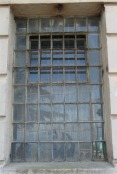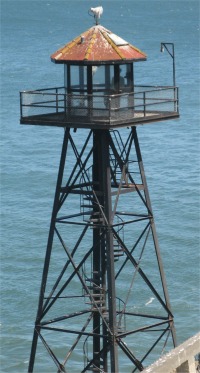 Watch Tower |
The journey was a short 1.5 miles hop, and soon we were docking on the far side of the island, where over a hundred individuals fired up with morbid curiosity spilled out onto the dock. We were given a quick briefing by a ranger: the dos and don'ts of the island, restroom locations, orientation video theatres and cell block audio tour starting point, and then left to our own devices. I headed straight to the orientation centre, with its surrounding exhibits and historical display boards, to learn the story behind the island. The video gave an excellent account.
|
|
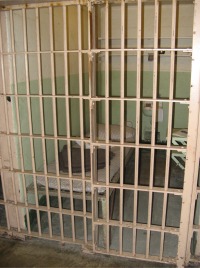 Standard Cell |
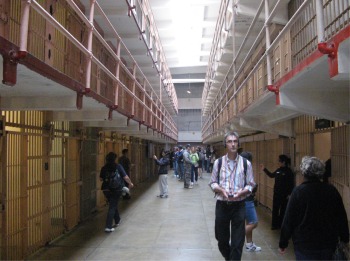 Three Tier Rows of Cells |
The island became a penitentiary prison in 1934. During the 29 years it was in use, the jail held such notable criminals as Al Capone, Robert Franklin Stroud (the Birdman of Alcatraz), George "Machine Gun" Kelly, James "Whitey" Bulger, Bumpy Johnson, Mickey Cohen, Arthur R. "Doc" Barker and Alvin Karpis. It also provided housing for the Bureau of Prison staff and their families.
During its 29 years of operation, the penitentiary claimed no prisoners had ever successfully escaped. 36 prisoners were involved in 14 attempts, two men trying twice; 23 were caught, six were shot and killed during their escape, and three were lost at sea and never found. The most violent occurred in 1946 when a failed escape attempt by six prisoners led to the so-called Battle of Alcatraz.
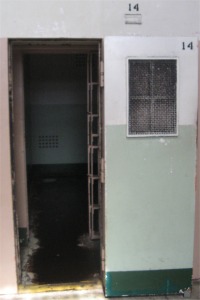 Solitary Confinement Cell |
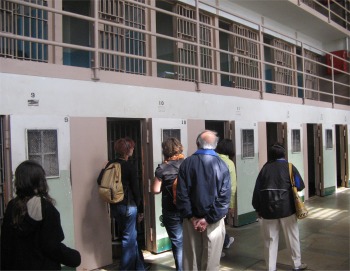 Isolation Block with Solitary Confinement Cells at the Bottom |
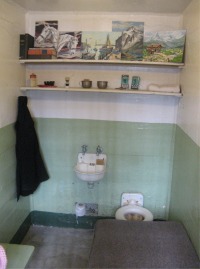 Home-Sweet-Home |
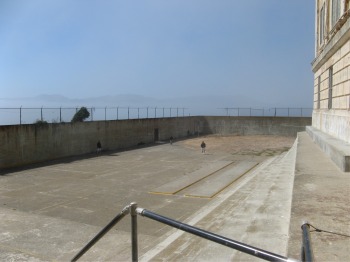 Exercise Yard |
In 1969, a group of Native Americans from many different tribes occupied the island, and proposed an education center, ecology center and cultural center. According to the occupants, the Treaty of Fort Laramie (1868) between the U.S. and the Sioux included provisions to return all retired, abandoned or out-of-use federal land to the Native people from whom it was acquired. The occupation was stormed by the FBI and forcibly ended in 1971.
Once armed with the history of the isle, I climbed up to the cell block and picked up an audio guide, and toured the building. There were four 3-story blocks of stark cells inside the building, one block being an isolation block which included a number of solitary confinement cells. Prisoners spent between 16 and 23 hours every day alone in these cells, equipped with only a toilet and bunk. Typically the cells would measure 5' by 9'. A library existed to one side of one of the blocks, and inmates would often read up to 100 books per year. The canteen area was equally stark. Here prisoners would spend 20 minutes each meal time. This was a potentially dangerous area; prisoners would be in possession of knives, forks and spoons which could be turned into weapons. Along one wall which faced all the corridors between the blocks, there was a gun gallery, caged in of course like everything else in the prison. This was where armed guards would parade maintaining their vigil. The worst job for the correction officers was watch-tower duty, an eight hour stint alone out in the cold bay wind.
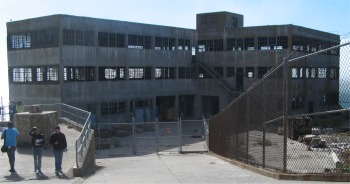 'Model Factory' where Model Prisoners Earned Their Pocket Money |
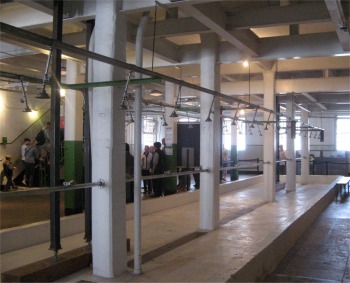 Shower Block |
I entered back into the cell block, and crossed to the administration centre where the control room for the prison resided. It also housed the warden's office. Outside it was the lighthouse, the ruins of the warden's house, and below lay the old military parade ground where prison officers' children would have played.
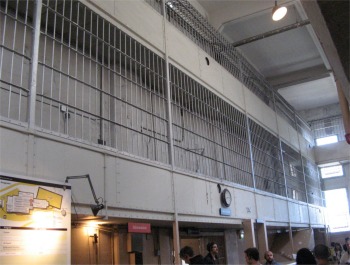 Gun Gallery |
As I left the island, I wondered if any of the prisoners had really been rehabilitated, or whether their souls were still decaying like the islands buildings. I'll never know the truth to that.
In the evening, despite not feeling 100%, I decided to venture out into the streets of San Francisco, with no particular aim. I ended up crossing through Chinatown to Columbus, a main diagonal thoroughfare crossing the city. It contained a lot of restaurants and bars and seemed to possess some nightlife. Passing by a side street, I heard the sound of a blues band from a bar, that at first sight I would have classified as sleazy, but the music sounded good, so I ventured in. Inside was a very lively atmosphere with all manner of life engaged in animated conversations. A solitary bartender was rushed off his feet trying to supply demands from his customers. In the far corner, a lead guitarist, a bass guitarist (who looked a bit like Hank Marvin in his younger days), and a drummer effortlessly and professionally played out a varied collection of blues music. They were a pretty tight and competent outfit, and won a lot of applause from folk in the bar. A core of dancers were doing their stuff in the cramped area in front of the band. The bar wasn't exactly large, and when a woman came in with a can containing flowers that she was selling, as she swung round her handbag caught me. I hadn't a clue what she carried in the bag, but the weight of it nearly knocked me off my feet. Later on, a girl came in dressed up as a cinema usherette, and she had a tray dangling from her neck containing candies and nibbles that she was peddling. Bizarre! It was even more bizarre when she wandered up the dance area and started doing a semblance to the can-can.
A young chap sat on the next bar stool to me, at an angle so that he was facing me, and kept giving me amorous looks. This made me feel uncomfortable, but rescue came in the form of a couple who were sitting on the other side of me. They were from Scotland, and were doing a multi-city break over in the US. They had done something similar the year before, and had discovered the bar we were now sitting in, and had wanted to return to it. We had a long chat about our travel exploits, and how we each rated different cities in America. The lad also had made an interesting observation on American eating habits. He had noticed that a lot of Americans would order a starter and main course in a restaurant. They would attempt to complete eating the starter, sometimes without success, and often the whole main course would be taken home in a doggy bag. This was a whole new meaning to a takeaway.
It seemed that the couple were not the only ones to return to this bar from far off lands. Further along the bar was a New Zealander who kept a motorbike here, and returned for a month every summer. The world was indeed becoming a smaller place when folk were able to visit favourite watering holes at the other end of the planet. Things livened up more when a group of Aussies entered the bar; they affectionately called me the Pommie. People came and left the bar all evening, or all morning, depending on the way you look at it, and an old guy stalked around the door with a torch checking the ID of all young people entering (Dan was always getting his ID checked over here). The bar was still heaving and the music playing as I departed at 01:30 in the morning.



